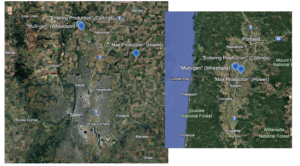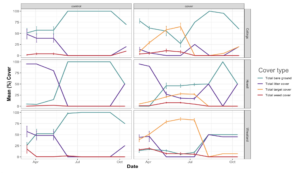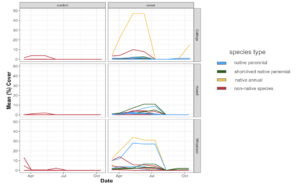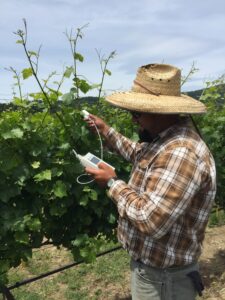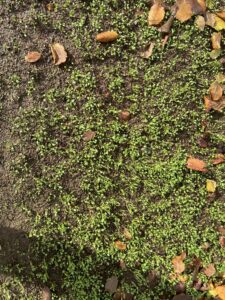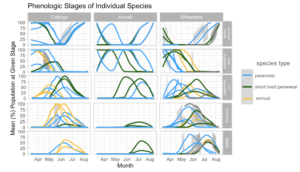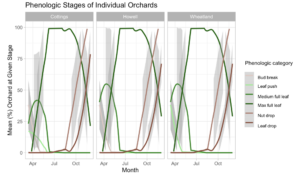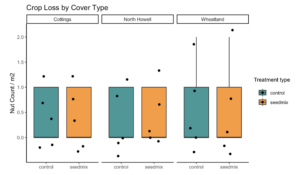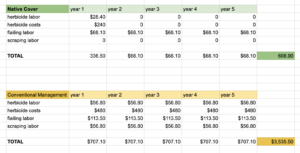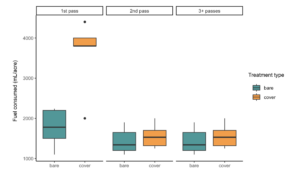Final report for GW23-251
Project Information
As U.S. nut industries expand, creative solutions are needed to develop and promote sustainable orchard management. Like other orchards in the West, Willamette Valley hazelnut orchards are typically managed with extensive herbicide, mowing, and ground scraping to maintain a bare-ground understory for mechanical nut harvest. These treatments lead to erosion, water contamination, and soil compaction. Cover cropping has been used to combat these issues in other systems, but is challenging to apply in hazelnuts as conventional cover crops interfere with harvest. My preliminary research indicates that native plants may be a viable cover crop alternative, as they suppress weeds and reduce erosion while also senescing before harvest. However, for native cover crops to be widely adopted, they must be economical and effective across different orchard ages. Here I develop and experimentally test native seed mixes tailored to be self-sustaining (to reduce labor and seed cost) and suited for different orchard ages. I will compare native cover crops to conventional practices, both for cost to implement, and benefit to the farmer and surrounding community. I will measure monetary, mechanical, and labor inputs towards cover crop maintenance, measure weed suppression by target cover, and multi-year viability in relation to mechanical treatment resistance. I will disseminate results and associated best practices through educational events, brochures, and an open-access website containing information and resources dedicated to helping farmers, professionals, and other researchers implement native cover crops in hazelnut orchards. This research will propel western orchard management toward a more economically and biologically sustainable future.
- Research objective 1) Develop self-sustaining, economically feasible native seed mixes for two types of hazelnut orchards (entering production and max production) and evaluate their compatibility with orchard management goals.
- Research objective 2) Evaluate the economic impacts of both native cover cropping and conventional, bare-ground orchard management practices. Compare orchard floor management expenses across both cover cropped and non-cover cropped areas.
- Educational objective 1) Familiarize hazelnut growers to native cover crops and empower them to use them effectively for their operational goals.
-
Educational objective 2) Outreach to additional hazelnut farmers to increase cover cropped orchards.
- 2a) Pass out informational brochures at hazelnut-related events.
- 2b) Create a technical guide for cover cropping with native plants in hazelnut orchards.
Cooperators
- - Producer
- - Producer
Research
Research objective 1) Develop self-sustaining, native seed mixes for two types of hazelnut orchards (entering production and max production) and evaluate their compatibility with orchard management goals:
We will develop native seed mixes based on orchard management goals like compatibility to hazelnut life-cycle, disturbance-resistance, and competitiveness against agricultural weeds. To test compatibility, will measure the seed mix population’s response to mechanical treatments, performance in each orchard type, and ability to suppress/compete with orchard weeds over the duration of the project. We hypothesize that 1) newly designed native cover crop mixes will be compatible with their selected orchard types (‘entering-production’ and ‘max-production’) and 2) the mechanical treatments associated with hazelnut orchard management. We hypothesize that these seeded populations 3) will support self-regenerating cover crop communities that 4) suppress agricultural weed populations for the duration of the study. 5) We also hypothesize that these new seed mixes will be as vigorous in establishment and persistence as the seed mix established in the Lane-Massee’s ‘multi-generational’ orchard in 2021.
Methods:
We developed seed mixes based on the listed criteria: compatibility to hazelnut life-cycle, disturbance-resistance, competitiveness, plant height, and price. In September of 2023, we purchased local biotypes of all native cover species from Heritage Seedlings & Liners in Salem, Oregon. Each orchard type received a seed mix catered to its canopy density, with the ‘entering production’ orchard receiving a full/part-sun seed mix and the ‘max-production’ orchard receiving a full-shade seed mix (see seed mix table).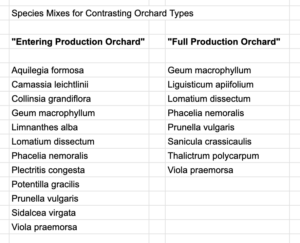
Each project site was seeded with a two acre block of native cover at one corner of the orchard, placement determined by farmer preference. After hazelnut harvest in 2023, we prepared our sites for the project. To prepare the sites, we removed leaves from the seeding area using a Flory sweeper. We then broadcast sprayed a 6% concentration of glyphosate to kill any vegetation present. We waited fourteen days for the vegetation to die off and the herbicides to break down before seeding. After removing any additional fallen leaves, the seed mixes were then roughly spread at a rate of 60g/6m using a hand-held broadcast seed spreader, with the seed ratios being calculated by seed weight and mature plant size.
Our mechanical treatments will take place May through July and consist of summer flailing and scraping, both to be determined by farmer preference for adequate orchard floor texture to fulfill hazelnut harvest requirements. After these processes take place, a final flail will happen to crush up any blank nuts that have fallen. A month later, after the majority of nuts have fallen, the project sites will be harvested using each farmer’s personal harvesting equipment. During harvest, we will collect nut-entanglement data to ensure our cover crops do not interfere with the harvesting process by entangling nuts in vegetation. To collect this data, we will wait until the harvester has picked through our flailed plots and a section of the non-cover cropped (control) orchard. We will lay a 1m x 1m quadrat in the center of orchard alleys which have been picked (20 cover and 20 control) and collect the leftover nuts. We will then compare the cover crop entanglement rate with the control entanglement rate. We will then continually evaluate each species and seed mix for their regenerative, reseeding, and weed suppression capabilities throughout the following fall, winter, and spring using the methods discussed below.
To test each of our hypotheses, we have embedded data collection plots inside of the larger two-acre blocks. Each plot is one 6m x 6m tree block that is not in the presence of a seed mix block edge. Plots are replicated five times per seed mix / orchard type.
To test hypotheses 1-3, we are measuring each species and seed mix community’s disturbance response. We will measure species and seed mix growth throughout the years by their responses to mechanical treatments, their ability to produce viable seed prior to timed treatments, and ability to produce regrowth and/or establish a new generation after the conclusion of mechanical treatments. We will survey these variables every 2-4 weeks, depending on outdoor ambient temperatures and weather patterns, surveying in shorter intervals during the height of the spring and summer months. Our hypotheses will be supported if each annual species reaches maturity and each perennial species reaches maturity in a two-year window, if each seed mix/perennial species regrows after harvest, and if each species produces viable seeds prior to the allotted flailing window.
To test hypothesis 4, agricultural weed exclusion, we will measure percent cover of seeded species vs non-seeded species every 2-4 weeks inside of these plots. We will factor in bare-ground, debris, and disturbance as part of the percentages. Our hypothesis will be supported if our seed mixes retain ≥75% of ground coverage during their height of growth (June/July) and weed species occupy ≤ 25% cover by that time frame.
To test hypothesis 5, establishment vigor and persistence, we will compare data across the 2022-2023 growing season for the ‘multi-generational’ orchard to the new plantings and their data in the 2023-2024 growing season. We will continue to collect data for all three cover crop types every year to determine that each hazelnut orchard is meeting the hypothesis criteria for cover crop success. Our hypothesis will be supported if the ‘multi-generational’, ‘entering-production’, and ‘max-production’ cover crop seed mixes have similar disturbance-response and weed-suppression data. We will quantify efficacy by comparing seed mix types by disturbance-response and weed-suppression ratios.
Research objective 2) Evaluate the economic impacts of both native cover cropping and conventional, bare-ground orchard management practices. Compare production expenses across both management regimes. We will evaluate each orchard management strategy for total labor, flailing and scraping, herbicide, and other cover-cropping related management costs. We hypothesize that 1a) native seed mixes will require less labor hours, number of flailing and scraping treatments, and quantity of herbicide treatments to manage, compared to conventional management practices. Overall, we hypothesize that 1b) native cover cropping in Willamette Valley hazelnut orchards can reduce overall operational costs for farmers.
Methods:
To test our hypotheses, we will test each variable on a two-acre scale, comparing these management blocks’ (cover cropped vs. conventional) inputs (monetary, labor, and mechanical). We will (1a) measure labor ($/acre), the number of times flailing and scraping treatments are performed, and the quantity (mL/acre) of diesel used in relation to flailing orchard floor management. To calculate the labor input, we will measure the number of hours that are invested into each management block for orchard floor treatment (herbicide spraying, flailing, scraping, and harvesting). To measure flailing and scraping inputs, we will evaluate the number of treatments each management block receives. For example, one flailing treatment will be measured by the completion of flailing the entire management block one direction (North-South or East-West).
To collect and record data, we will use online spreadsheets to enter data, with each farmer having access to their individual spreadsheets. Both farming operations will enter their data after the completion of the treatment, with data being a combination of quantitative and qualitative data. Both farming groups are technologically equipped and knowledgeable, making online processes smoother for all parties than paper data collection.
We will evaluate hypothesis (1b) at the end of the data collection period, by analyzing the time spent and costs of each activity, and summarizing our findings and comparisons between the two management strategies (cover cropped vs. conventional). We will compare the differences of economic input by management strategy on a ten-acre scale (2b). Because the two farms will be receiving different seed mixes based on orchard light availability, each seed mix will likely require slightly different management strategies, so this will also be taken into account and recorded. The ‘entering-production’ orchard will likely be mowed earlier in the growing season compared to the ‘max-production’ orchard. Our hypotheses will be supported if each seed mix type can reduce farmer monetary, labor, and time inputs by statistically significant margins.
Community Composition
Figure 1 (left) - community composition by cover type. Native cover successfully outcompeted weed cover in all three orchard settings up through cover annual termination (flailing in July-August). Cover also effectively reduced bare ground compared to controls, which are often flailed 3-5 times over the course of May - September. Cover was highest at the Wheatland and Cottings sites and lower at the Howell site due to the lack of annuals in the site mixture. The Howell cover mixture is likely to take three years to mature, as many of the species in that mixture are long-lived perennials that took three years to mature at the Wheatland site.
Figure 2 (right) - community composition by species type. In both the Cottings and Wheatland orchards, native annuals outperformed all other cover types. In the Wheatland orchard, perennial cover came close to annual cover, both far outperforming all other cover types. Due to no annuals being included in the mix at Howell, short-lived perennials outperformed all cover types, with perennials coming in second. Non-native cover was most present in the Cottings and Wheatland orchards due to light availability, but was still suppressed by all native species. The control saw a lack of cover from all target species and reduced cover from non-native species due to continuous management in alignment with bare-ground management practices.
Our hypotheses where that 1) newly designed native cover crop mixes will be compatible with their selected orchard types (‘entering-production’ and ‘max-production’) and 2) the mechanical treatments associated with hazelnut orchard management. We hypothesized that these seeded populations 3) would support self-regenerating cover crop communities that 4) suppressed agricultural weed populations for the duration of the study. 5) We also hypothesize that these new seed mixes will be as vigorous in establishment and persistence as the seed mix established in the ‘multi-generational’ orchard in 2021.
Overall, our first and second hypotheses were supported. Both cover crop mixes designed for their orchard conditions thrived enough to go to seed, also being compatible the associated mechanical treatments. We are also finding our third hypotheses to be supported, though evidence is limited at the moment as a full data set will only be available this upcoming spring when the species fully regenerate. Thus far, both the Howell (left) and Cottings (right) sites have annual and short-lived perennial regeneration (see pictures below). Our 4th hypotheses was mostly supported, though the mean cover in the Howell orchard did not achieve our desired establishment vigor (H5), likely due to orchard canopy cover and limited light availability. We expect this seed mix's vigor to increase each coming year and the plants mature.
Phenology
Figure 1 (left) - Phenologic stages of individual cover species. Most species at most sites went to seed, except for those perennial species in the establishing sites (Howell and Cottings).
Figure 2 (right) - Phenologic stages of orchard sites. Orchard phenology was largely replicated across sites, though the Cottings site often showed advanced phenology likely due to the younger age of the trees and orchard light availability.
Across both figures, species phenology lined up well with orchard phenology. Cover species experienced full vegetation during peak right before or during peak orchard canopy leaf fullness, ensuring that the cover is adequately developing in time to flower and create seed. Flowering and seed production occurred during two intervals in the light-available orchards right after a full canopy was achieved. For all three sites, seed production was effectively achieved prior to nut drop, ensuring that (H2) all cover crops aligned with the mechanical treatments associated with hazelnut orchard management.
Nut Entrapment
Our findings show that none of the seeded mixes contributed to nut entrapment during mechanical harvesting.
Economic breakdowns:
Input costs estimated over a five year period (with results collected from year 1):
Fuel use over multiple flail passes (with results collected from 2 flail passes, with 3+ being estimated according to vegetation load and fuel consumption of the 2nd pass)
For our economic hypotheses, both were supported as each seed mix type effectively reduced the time, labor, and monetary inputs of the farmer. With baseline data consisting of labor of herbicide application, flailing, and scraping, and herbicide input costs suggests that native cover may reduce orchard floor labor and input costs by ~$2,900 on a ten acre scale over a five year period. Flailing fuel use was exponentially higher in the cover crop block during the first pass due to a higher biomass load compared to the bare-ground block, though in the second pass, cover was very close to fuel use levels of the bare-ground block after the cover was flailed down to the ground. We expect that every flail pass after would grow closer to the control (hence the 3+). Due to the bare-ground treatment being flailed an average of five times per season across all three sites, and the cover being flailed three times per season across all three sites, farmers may likely see an average of ~1/3 gal of fuel being saved per acre using the native cover, though this is not statistically significant.
Research outcomes
Throughout the research process, we have determined that species selection is quite daunting and complicated. Especially given the various conditions of each orchard, the price and availability of native seed, and the ways in which individual species respond to each orchard condition that they ultimately face during the trial process. I would recommend for future native cover crop studies, picking a solid core of five cover crop species that have demonstrated their ability to grow in a variety of perennial agriculture systems, and then using functional trait information of other available species, and pick the species most likely to do well in the given conditions. It is especially important to acknowledge management of the perennial agriculture system when picking these species, as phenology and management type and timing play huge roles in cover crop success. If there is the ability to split up a seed mix in a 1:3 or 2:5 ratio of annuals to perennials, we have seen that annuals do a good job of suppressing weeds in years one and two, followed by the filling-in and perennial cover domination of orchard floor in years two and three. There are some exceptions, as some annuals do very well at being distributed by mechanical disturbance, thus still thriving and expanding local range in year 3. This can be used to the managers advantage. In hindsight, I would also consider adding native perennial grasses to the mix to ensure that non-native grasses to not have the change to invade unoccupied niches in the cover cropped area. In orchards with high light availability, perennial grasses had the chance to establish in the early months when mean cover percent was lower, and if they had gotten a foothold, they may have been able to persist.
Native cover is expensive, but it can also be a long-term solution to many modern agricultural issues that conventional cover crops may not have the ability to overcome. Due to the self-sustaining nature of native species, we have found that the likelihood for input cost reduction in orchard floor management could be in the magnitude of thousands of dollars on a multi-acre scale.
Education and Outreach
Participation summary:
We hosted one field day and multiple private tours at the cover cropped sites. Our one field day was in late May and hosted an educational tour for farmers, employees for the NRCS, multiple water conservation districts, and the Xerces Society. For our private tours, we hosted a director of the USDA's Institute of Bioenergy, Climate, and Environment, an agronomist from the Ferrero Hazelnut Company, and staff of the non-profit 'SalmonSafe'.
We spoke at multiple events including participating on the Marion County Soil Water Conservation District "Cover Crop Day" panel, presented at the Benton County Soil Water Conservation Districts "Soil Health Day", passed out handouts and spoke at the NRCS's Hazelnut Cover Crop Day, passed out handouts and networked with farmers at the Nut Growers Society Summer Tour, presented at the Oregon Organic Hazelnut Tour, presented at the National Native Seed Conference, and spoke at the winter Nut Growers Society Meeting. All events involved many farmers, researchers, members of various government agencies, and soil water conservation districts.
Because meetings and private tours were often set up on a whim due to word-of-mouth by farmers and different agencies/organizations, we always came equipped to events with handouts that included our lab website, phone number, and email addresses so individuals could reach out as needed.
Over the course of these events, we reached nearly the entire Oregon hazelnut industry (~800 family farms) with our main cover crop messaging. We successfully distributed around 200 handouts discussing native cover crop information, and developed working relationships with around 30 hazelnut farmers. We successfully enhanced our relationship with the Nut Growers Society of Oregon, the Hazelnut Industry Office, and Oregon State University's Hazelnut Extension Program. In addition, using this information, developed a connection with Ferrero's Hazelnut Company.
We effectively engaged with producers through being available during the work week to meet with them in person, at their farm, or at industry hosted events. We found it very important that the atmosphere be casual, in a familiar environment, and at the pace of the farmer.
Over the course of these events, we reached nearly the entire Oregon hazelnut industry (~800 family farms) with our main cover crop messaging. We successfully distributed around 200 handouts discussing native cover crop information, and developed working relationships with around 30 hazelnut farmers. We successfully enhanced our relationship with the Nut Growers Society of Oregon, the Hazelnut Industry Office, and Oregon State University's Hazelnut Extension Program. In addition, using this information, developed a connection with Ferrero's Hazelnut Company.
We effectively engaged with producers through being available during the work week to meet with them in person, at their farm, or at industry hosted events. We found it very important that the atmosphere be casual, in a familiar environment, and at the pace of the farmer.
